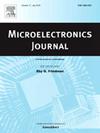Single-step electron beam evaporation for integrated dual-metal gate and gate field-plate in GaN-on-Si MIS-HEMTs
IF 1.9
3区 工程技术
Q3 ENGINEERING, ELECTRICAL & ELECTRONIC
引用次数: 0
Abstract
This work reports the demonstration high performance GaN-on-Si metal-insulator-semiconductor (MIS) high-electron-mobility transistors (HEMTs) featuring dual-metal gate (DMG) and gate field-plate (GFP) structures. The DMG-GFP structures can be realized in a single step by adjusting the angle of electron beam evaporation, eliminating the requirement for multiple process steps. Higher carrier transfer efficiency and more uniform electric field distribution of the DMG-GFP-HEMTs (gate to drain distance LGD of 18 μm) result in a pronounced enhancement of drain current (ID) and transconductance (Gm) by 15 %, a remarkable breakdown voltage (Vbr) increases of 44.9 %, and a significantly reduced current collapse over the single metal gate (SMG) control devices. Besides, the Vbr of DMG-GFP-HEMTs exhibits a noteworthy 16.8 % improvement compared to SMG-GFP-HEMTs, further validating the advantageous impact of the DMG structure on Vbr performance. Weibull analysis at 25 °C extrapolated a 10-year maximum operating gate voltage of 6.4 V for DMG-GFP HEMTs, a 16.3 % improvement over SMG-GFP HEMTs. The mechanism of DMG-GFP structures for suppressing current collapse has also been investigated, where the DMG structure helps to weaken the electron capture effect on the AlGaN/SiNx interface and the GFP structure enables the timely release of trapped electrons.
GaN-on-Si miss - hemt集成双金属栅极和栅极场板的单步电子束蒸发
这项工作报告了具有双金属栅极(DMG)和栅极场板(GFP)结构的高性能GaN-on-Si金属绝缘体半导体(MIS)高电子迁移率晶体管(hemt)的演示。DMG-GFP结构可以通过调整电子束蒸发角度一步实现,省去了多个工艺步骤。dmg - gfp - hemt(栅极与漏极距离LGD为18 μm)具有更高的载流子转移效率和更均匀的电场分布,导致漏极电流(ID)和跨导率(Gm)显著提高15%,击穿电压(Vbr)显著提高44.9%,并且在单金属栅极(SMG)控制器件上显著降低了电流崩溃。此外,DMG- gfp - hemts的Vbr比SMG-GFP-HEMTs提高了16.8%,进一步验证了DMG结构对Vbr性能的有利影响。在25°C下,Weibull分析推断DMG-GFP hemt的10年最大工作栅极电压为6.4 V,比SMG-GFP hemt提高16.3%。DMG-GFP结构抑制电流崩溃的机制也被研究,其中DMG结构有助于减弱AlGaN/SiNx界面上的电子捕获效应,而GFP结构能够及时释放被捕获的电子。
本文章由计算机程序翻译,如有差异,请以英文原文为准。
求助全文
约1分钟内获得全文
求助全文
来源期刊

Microelectronics Journal
工程技术-工程:电子与电气
CiteScore
4.00
自引率
27.30%
发文量
222
审稿时长
43 days
期刊介绍:
Published since 1969, the Microelectronics Journal is an international forum for the dissemination of research and applications of microelectronic systems, circuits, and emerging technologies. Papers published in the Microelectronics Journal have undergone peer review to ensure originality, relevance, and timeliness. The journal thus provides a worldwide, regular, and comprehensive update on microelectronic circuits and systems.
The Microelectronics Journal invites papers describing significant research and applications in all of the areas listed below. Comprehensive review/survey papers covering recent developments will also be considered. The Microelectronics Journal covers circuits and systems. This topic includes but is not limited to: Analog, digital, mixed, and RF circuits and related design methodologies; Logic, architectural, and system level synthesis; Testing, design for testability, built-in self-test; Area, power, and thermal analysis and design; Mixed-domain simulation and design; Embedded systems; Non-von Neumann computing and related technologies and circuits; Design and test of high complexity systems integration; SoC, NoC, SIP, and NIP design and test; 3-D integration design and analysis; Emerging device technologies and circuits, such as FinFETs, SETs, spintronics, SFQ, MTJ, etc.
Application aspects such as signal and image processing including circuits for cryptography, sensors, and actuators including sensor networks, reliability and quality issues, and economic models are also welcome.
 求助内容:
求助内容: 应助结果提醒方式:
应助结果提醒方式:


